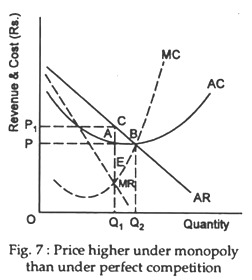We often make a comparison between monopoly and perfect competition. Such a comparison is done in Fig. 7. If Fig. 7 represented the position of a firm under perfect competition then the equilibrium output would be OQ (where P = MC) and the price would be OP.
If, however, the diagram were to represent a monopoly situation, the equilibrium output would be OQ1 (where MR = MC) and the price would be OP1. Thus monopoly output is less than competitive output but monopoly price is higher than competitive price. This supply means that if a firm does not have any competitors to fear, then it is in a position to raise its price.
Cost considerations:
ADVERTISEMENTS:
The comparison made here rests on the assumption that the cost curves are the same in both types of markets. Such an assumption may not be correct. Because the monopolist is the only producer of the commodity, he is likely to be a very large firm that can secure economies of scale.
If he can derive the advantages of large-scale production, then his marginal and average costs would be lower than those of a perfectly competitive seller. If this is so, monopoly price will be lower and output higher than under perfect competition.
Yet the fact remains that a restriction of competition, as under monopoly, is likely to lead to higher prices and some other form of exploitation. This is why the government takes various actions to control monopolies and restrictive trade practices.
Merits:
ADVERTISEMENTS:
However, monopolies have potential advantages also. If by concentrating production into one firm economies of scale are secured, the benefits arising from this may be passed on to the consumers. In other words, price can be reduced when costs fall. This is possible only when a commodity is produced on a very large scale in a single plant.
Moreover, in some situations it would be wasteful to have the unnecessary duplication of a service which would accompany competition. If, for instance, the post office is privately owned, two postmen would go to the same village to deliver one letter each.
Again, the existence of monopoly power does not necessarily involve the misuse of that power. Monopolist does not always raise price as far as he can. If railways charge exorbitant fares, people may switch over to road transport.
A monopolist may refrain from raising price as far as he can because he does not want to encourage the entry of new firms into the industry. If the excess profits are very high, potential new entrants may try to find ways of overcoming whatever barriers have hitherto kept them out of the industry.
ADVERTISEMENTS:
Demerits of Monopoly:
Monopoly price is likely to be higher than competitive price. This is one major argument against monopoly. A monopolist usually charges as much as the traffic will bear. So consumers are exploited and there is loss of consumer welfare.
Another drawback of monopoly, again from the consumer’s welfare point of view, is the lack of choice. The monopolist is the sole supplier of the commodity. So the consumer cannot express dissatisfaction by turning to a competitor’s product.
The third drawback of monopoly is loss of product quality. The lack of competition may lead to complacency. He may lead a quiet life without being bothered almost rivals because he has none. As a result efficiency may decline and low quality product may be supplied. People often complain about the quality of food served in railway restaurants.
Such restaurants find themselves in a monopoly position because customers have nowhere else to go unless they bring their own food. If there were two or three suppliers in the same station in competition with one another, one might expect the complaints about standards to be reduced as each of the competitors would try to ensure that the customers come to them again and again.
